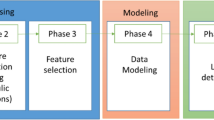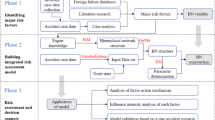Abstract
Underground pipelines are an indispensable part of urban public facilities. However, the frequent occurrence of pipeline accidents in recent years has not only brought great inconvenience to people’s lives, but also affected people’s lives and property safety to a certain extent. Therefore, timely treatment and treatment are very important. Preventing sudden underground pipeline accidents plays an important role in improving urban livability. This article studies pipeline risk big data intelligent decision-making systems based on machine learning and situational awareness. In this paper, by analyzing the application scope of gas leakage and diffusion models under different modes, leakage, diffusion, fire and explosion models are determined, and a combined model framework of leakage accident consequence system analysis is formed. The system uses the pipeline failure probability model and the pipeline failure consequence analysis model to determine the pipeline failure probability, the probability and the consequences of each accident; it uses the spatial analysis ability of GIS technology to determine the accident impact area and displays the impact area in graphics form. Through the effect verification of the test set, the prediction result of the SVR model based on the grid search parameter, the relative percentage error of the predicted value of each sample and the true value fluctuate is in the range of 4%-36%, and the amplitude is not very large. Most of the error values are approximately 13.56% of the MAPE value. The results show that the optimization method using grid search parameters can have better prediction performances.













Similar content being viewed by others
References
Ariel L, Yarnold PR (2018) Using machine learning to evaluate treatment effects in multiple-group interrupted time series analysis. J Eval Clin Pract 24(4):740–744
Mohammadi M, Al-Fuqaha A (2018) Enabling cognitive smart cities using big data and machine learning: approaches and challenges. IEEE Commun Mag 56(2):94–101
Maldonado-Mahauad J, Perez-Sanagustin M, Kizil Ce CRF et al (2018) Mining theory-based patterns from Big data: Identifying self-regulated learning strategies in Massive Open Online Courses. Comput Hum Behav 80(3):179–196
Valerio P, Antonio P, Antonio P et al (2018) Benchmarking big data architectures for social networks data processing using public cloud platforms. Futur Gener Comput Syst 89(12):98–109
Helma C, Cramer T, Kramer S et al (2018) Data mining and machine learning techniques for the identification of mutagenicity inducing substructures and structure activity relationships of noncongeneric compounds. J Chem Inf Comput 35(4):1402–1411
Ghafir I, Hammoudeh M, Prenosil V et al (2018) Detection of advanced persistent threat using machine-learning correlation analysis. Futur Gener Comput Syst 89(12):349–359
Kumar P, Huan TL, Li X et al (2018) Panchromatic and multispectral remote sensing image fusion using machine learning for classifying bucolic and farming region. Int J Comput Sci Eng 15(5/6):340–370
Lujan-Moreno GA, Howard PR, Rojas OG et al (2018) Design of experiments and response surface methodology to tune machine learning hyperparameters, with a random forest case-study. Expert Syst Appl 109(11):195–205
Sotgiu C, Weigand B, Semmler K (2018) A turbulent heat flux prediction framework based on tensor representation theory and machine learning. Int Commun Heat Mass Transfer 95(7):74–79
Raghu S, Sriraam N (2018) Classification of focal and non-focal EEG signals using neighborhood component analysis and machine learning algorithms. Expert Syst Appl 113(12):18–32
Altay B, Dokeroglu T, Cosar A (2018) Context-sensitive and keyword density-based supervised machine learning techniques for malicious webpage detection. Soft Comput 23(4):1–15
Ren D, Zhang Y, Xiao N et al (2018) Word-Fi: accurate handwrite system empowered by wireless backscattering and machine learning. IEEE Network 32(4):47–53
Rosa FD, Jousselme AL, Gloria AD (2018) A reliability game for source factors and situational awareness experimentation. Int J Serious Games 5(2):45–64
Rapuzzi R, Repetto M (2018) Building situational awareness for network threats in fog/edge computing: Emerging paradigms beyond the security perimeter model. Futur Gener Comput Syst 85(8):235–249
Laatikainen O, Samarina T, Haapea P et al (2020) Participatory monitoring as a supportive tool for better situational awareness in contaminants’ leakage and prevention of environmental pollution. Procedia Environ Sci 7(1):131–136
Tamunosiki-Amadi JO, Okolai DG (2020) Situational awareness and employee commitment in the health sector of Bayelsa state. Int J Eng Technol Manag Res 6(8):1–11
Dafaallah DE, Hashim AS (2020) Sentiment analysis techniques to analyze hse situational awareness at oil and gas platforms using machine learning. Indian J Comput Sci Eng 11(5):640–645
Adrian H (2020) Assessing situational awareness of universities concerning student dropout: a web-based content analysis of Romanian Universities’ Agenda. J Res Higher Educ 4(2):18–34
Zhang Y (2018) Key technologies of confrontational intelligent decision support for multi-agent systems. Autom Control Comput Sci 52(4):283–290
Wang Y, Kung LA, Byrd TA (2018) Big data analytics: understanding its capabilities and potential benefits for healthcare organizations. Technol Forecast Soc Chang 126(1):3–13
Wang X, Zhang Y, Leung V et al (2018) D2D big data: content deliveries over wireless device-to-device sharing in large scale mobile networks. IEEE Wirel Commun 25(1):32–38
Meng XL (2018) Statistical paradises and paradoxes in big data (I): Law of large populations, big data paradox, and the 2016 US presidential election. Ann Appl Stat 12(2):685–726
Andre JC, Antoniu G, Asch M et al (2018) Big data and extreme-scale computing: pathways to convergence - toward a shaping strategy for a future software and data ecosystem for scientific inquiry. Int J High Perform Comput Appl 32(4):435–479
Chu JF, Wu J, Song ML (2018) An SBM-DEA model with parallel computing design for environmental efficiency evaluation in the big data context: a transportation system application. Ann Oper Res 270(1):105–124
Muhammad SS, Dey BL, Weerakkody V (2018) Analysis of factors that influence customers’ willingness to leave big data digital footprints on social media: a systematic review of literature. Inf Syst Front 20(3):559–576
Jain DK, Jain R, Lan X et al (2020) Driver distraction detection using capsule network. Neural Comput Appl 33(3):1–14
Jain D, Kumar A, Garg G (2020) Sarcasm detection in mash-up language using soft-attention based bi-directional LSTM and feature-rich CNN. Appl Soft Comput 91:106198
Jain DK, Kumar A, Sharma V (2020) Tweet recommender model using adaptive neuro-fuzzy inference system. Future Gener Comput Syst 112:996–1009
Jain DK, Lan X, Manikandan R (2020) Fusion of iris and sclera using phase intensive rubbersheet mutual exclusion for periocular recognition. Image Vis Comput 103(7):104024
Sinhal R, Ansari IA, Jain DK (2020) Real-time watermark reconstruction for the identification of source information based on deep neural network. J Real-Time Image Process 17(3):2077–2095
Graafland M, Bemelman WA, Schijven MP (2017) Game-based training improves the surgeon’s situational awareness in the operation room: a randomized controlled trial. Surg Endosc 31(10):4093–4101
Wang W, He L, Markham P et al (2017) Multiple event detection and recognition through sparse unmixing for high-resolution situational awareness in power grid. IEEE Trans Smart Grid 5(4):1654–1664
Yong L, Yao W, Zhou D et al (2016) Recent developments of FNET/GridEye—A situational awareness tool for smart grid. Csee J Power Energy Syst 2(3):19–27
Wang WQ (2016) Cognitive frequency diverse array radar with situational awareness. IET Radar Sonar Navig 10(2):359–369
Rapuzzi R, Repetto M (2018) Building situational awareness for network threats in fog/edge computing: Emerging paradigms beyond the security perimeter model. Future Gener Comput Syst 85:235–249
Perez-Londono SM, Olivar-Tost G, Mora-Florez JJ (2017) Online determination of voltage stability weak areas for situational awareness improvement. Electric Power Syst Res 145:112–121
Ghosh S, Ghosh D, Mohanta DK (2017) Situational awareness enhancement of smart grids using intelligent maintenance scheduling of phasor measurement sensors. IEEE Sens J 23:1–1
Kantra SD, Makram EB (2016) Development of the decoupled discreet-time Jacobian Eigenvalue approximation for situational awareness utilizing open PDC. J Power Energy Eng 04(9):21–35
Pahi T, Skopik F (2016) A public-private-partnership model for na-tional cyber situational awareness. IJCSA 1(1):31–53
Santos C, Filho N, Espíndola DB et al (2020) Situational awareness oriented interfaces on human-robot interaction for industrial welding processes. IFAC-PapersOnLine 53(2):10168–10173
Salminen-Tuomaala MH, Tiainen JT, Paavilainen E (2020) Situational awareness in the identification of abuse—Out-of-hospital emergency care providers’ experiences. Clin Nurs Stud 8(4):69–79
Costello DH, Xu H (2021) Relating sensor degradation to vehicle situational awareness for autonomous air vehicle certification. J Aerosp Inf Syst 18(4):1–10
Adurthi N, Singla P, Majji M (2020) Mutual information based sensor tasking with applications to space situational awareness. J Guid Control Dyn 43(4):1–23
Lyman WB, Passeri M, Murphy K et al (2020) The next step in surgical quality improvement: outcome situational awareness. Can J Surg 63(2):E120–E122
Lu W, Xu Q, Lan C et al (2020) Microservice-Based platform for space situational awareness data analytics. Int J Aerosp Eng 2020(6):1–22
Mills N, Silva DD, Alahakoon D (2020) Generating situational awareness of pedestrian and vehicular movement in urban areas using IoT data streams. IEEE Internet Things J 7(5):4395–4402
Zhao X, Yongchareon S, Cho NW (2021) Enabling situational awareness of business processes. Bus Process Manag J 27(3):779–795
Cokgormusler N (2021) The situational awareness & the port pilotage services. J ETA Maritime Sci 9(2):154–155
Qazi A, Qazi J, Naseer K et al (2020) Analyzing situational awareness through public opinion to predict adoption of social distancing amid pandemic COVID-19. J Med Virol 92(7):849–855
Al-Muharraqi MA (2020) Re: What can we do to improve individual and team situational awareness to benefit patient safety? - ScienceDirect. British J Oral Maxillofac Surg 58(7):873–874
Acknowledgements
This work was supported by National Natural Science Foundation of China (Research on Risk Assessment and Management of Offshore Oil and Gas Pipeline in Service (41877527)).
Author information
Authors and Affiliations
Corresponding author
Ethics declarations
Conflict of interest
The author states that this article has no conflict of interest.
Additional information
Publisher's Note
Springer Nature remains neutral with regard to jurisdictional claims in published maps and institutional affiliations.
Rights and permissions
About this article
Cite this article
Zhong, X., Zhang, X. & Zhang, P. Pipeline risk big data intelligent decision-making system based on machine learning and situation awareness. Neural Comput & Applic 34, 15221–15239 (2022). https://doi.org/10.1007/s00521-021-06738-5
Received:
Accepted:
Published:
Issue Date:
DOI: https://doi.org/10.1007/s00521-021-06738-5




